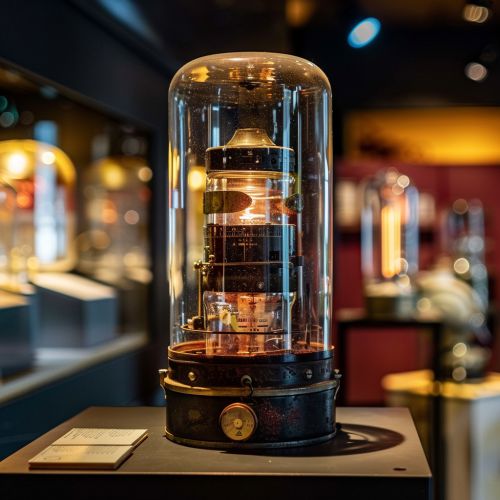Crookes tube
Introduction
The Crookes tube is a type of early experimental discharge tube, invented by the British scientist William Crookes in the late 19th century. It is a sealed glass container in which two electrodes are separated by a vacuum. When a high voltage is applied across the electrodes, cathode rays (later identified as a stream of electrons) are produced. The Crookes tube was a fundamental discovery in the development of atomic physics and led to the invention of the X-ray tube, the television, and the electron microscope.
History
The Crookes tube was developed from the earlier Geissler tube, an invention of the German physicist and glassblower Heinrich Geissler in 1857. Geissler tubes were used to study electrical discharges in gases at low pressure. However, they had limitations due to the high gas pressure inside the tube. William Crookes modified the Geissler tube by creating a better vacuum, which allowed for the observation of cathode rays.


Design and Operation
The Crookes tube consists of a partially evacuated glass bulb of various shapes, with two metal electrodes, the cathode and the anode. The cathode is usually a flat metal plate, while the anode is typically a metal cross, wheel, or maltese cross. The tube is connected to a high voltage power supply, which creates a potential difference between the electrodes. This causes the residual gas in the tube to ionize and produce a glowing plasma, which is visible as a colored light. The color of the light depends on the type of gas remaining in the tube and the level of vacuum.
Cathode Rays
The most significant discovery made using the Crookes tube was the existence of cathode rays. These are streams of particles, later identified as electrons, that are emitted from the cathode and travel to the anode. The rays are negatively charged, and their path can be deflected by a magnetic field. This was the first evidence of the existence of subatomic particles, and it laid the groundwork for the development of atomic physics.
Applications and Legacy
The Crookes tube was a crucial tool in the development of X-rays. In 1895, the German physicist Wilhelm Conrad Roentgen discovered that when he powered a Crookes tube, it emitted a new type of ray that could pass through solid matter and leave an image on a photographic plate. He named these rays X-rays, and their discovery revolutionized the fields of medicine and science.
The Crookes tube also played a significant role in the invention of the television. In the early 20th century, inventors like Philo Farnsworth and Vladimir Zworykin used the principles of the Crookes tube to develop the cathode ray tube (CRT), the key component of early television sets.
Furthermore, the Crookes tube was instrumental in the development of the electron microscope. The ability of the Crookes tube to produce a focused beam of electrons was adapted in the 1930s to create the first electron microscopes, which allowed for the imaging of structures too small to be seen with light microscopes.
